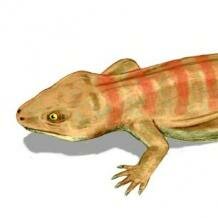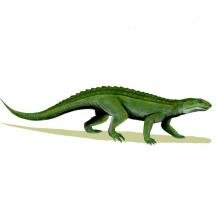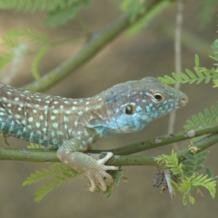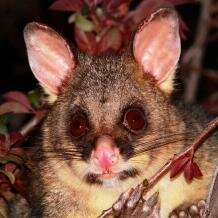Topic: Teiid lizard dentition: convergence with other reptiles, mammals and fish
Teiids are skink-like lizards whose members show a stunning diversity of tooth types, providing rich evidence of convergence within the teiids themselves, in distantly related reptile groups and even in certain mammals and fish.
 Teiids are a group of skink-like lizards that evolved in the early Cretaceous and whose members show a stunning diversity of tooth types, from simple, single cusped teeth to complex, multi-cuspid molariforms. Among teiids with complex dentition we find species with molar-like teeth expanded transversely, and others that are expanded along the anterior-posterior axis of the mouth; these cases provide rich evidence of convergent evolution, both within the teiids themselves, in distantly related reptile groups and even in certain mammals and fish.
Teiids are a group of skink-like lizards that evolved in the early Cretaceous and whose members show a stunning diversity of tooth types, from simple, single cusped teeth to complex, multi-cuspid molariforms. Among teiids with complex dentition we find species with molar-like teeth expanded transversely, and others that are expanded along the anterior-posterior axis of the mouth; these cases provide rich evidence of convergent evolution, both within the teiids themselves, in distantly related reptile groups and even in certain mammals and fish.
Transverse, chisel-like teeth in teiids and procolophonids
Polyglyphanodon
The so-called ‘polyglyphanodont’ teiids of the mid Cretaceous are generally characterized by transversely expanded teeth with two cusps (‘bicuspid’) joined by a low ridge, but in certain species (notably Polyglyphanodon sternbergi) the ridge forms a single, unified transverse blade. Upper and lower tooth rows interlock when Polyglyphanodon closes its jaws, so that the chisel-like blades create an efficient cutting and tearing action. Enhanced by fine serrations on the blade edges, this transverse dentition equipped Polyglyphanodon to be a highly specialized herbivore, capable of processing tough plant material. In a striking case of convergent evolution, Polyglyphanodon-like interlocking blades are also known in a distantly related reptile group known as procolophonids.
 Procolophonids
Procolophonids
Procolophonids were herbivorous ‘para-reptiles’ that lived from the mid Permian (265 Ma) to end Triassic (205 Ma). As relatives of mesosaurs and pareiasaurs, the procolophonids are evolutionarily separate from the two major groups of ‘diapsid’ reptiles, including the lizards from which teiids evolved. Species such as Procolophon trigoniceps and Sauropareion anoplus exemplify typical procolophonid dentition, in which chisel-like, transversely expanded teeth lie behind simple unicuspid front teeth. As in teiids, the upper and low tooth rows interlock upon jaw closure, such that the transverse blades occlude with the V-shaped spaces between opposite teeth, providing a powerful mechanism for shearing fibrous plant material. This modified, ‘chisel-like’ dentition clearly arose independently in teiids and procolophonids by convergence, allowing both Polyglyphanodon and Procolophon to become ecologically successful as specialized herbivores in their own time.
Anterior-posterior multi-cusped teeth
Teiids
As mentioned above, teiid lizards display a diversity of tooth forms. These include multi-cusped species with cusps orientated anterior-posteriorly, that is, aligned with the front-back axis of the mouth. Notable among the latter species are members of the extinct South American ‘Gymnophthalmidae’ teiids, and Asian polyglyphanodont teiids such as Macrocephalosaurus, Erdenetesaurus and Darchausaurus that lived in the early Late Cretaceous.  Iguana iguana” width=”218″ height=”218″>These teiids all possessed enlarged teeth with either two cusps (‘bicuspid’) or three cusps (‘tri-cuspid’) arranged anterior-posteriorly on the tooth surface, or crown.
Iguana iguana” width=”218″ height=”218″>These teiids all possessed enlarged teeth with either two cusps (‘bicuspid’) or three cusps (‘tri-cuspid’) arranged anterior-posteriorly on the tooth surface, or crown.
Iguanids and lacertids
Aside from the teiids, a few other lizard groups also bear bicuspid teeth with cusps arranged anterio-posteriorly, located behind simple, recurved teeth. For example, the lizard Iguana iguana has bicuspid teeth with finely serrated ridges (similar to serrations on the blade of Polyglyphanodon) that provide a basic cutting action, and some members of the lizard family Lacertidae also possess bicuspids. These multi-cusped teeth evolved independently in each group, providing a limited degree of mechanical processing due to shear between tooth rows and enhanced tooth-food contact surfaces.
Notosuchids
 Notosuchid crocodiles are classified as ‘archosaurs’, unlike lizards which are ‘lepidosaurs’, and yet they also evolved a form of multi-cusped molariform dentition with cusps oriented anterior-posteriorly. Notosuchus and its close relative Chimaerosuchus lived in the early Cretaceous, and possessed incredibly specialized occluding molariforms at the back of the jaw that served to process plant material or tough animal prey. The upper and lower molars had three rows of up to seven cusps that interlocked when the jaw was closed. Cusps were recurved and had a posterior cutting edge, so that rough dental occlusion combined with the atypical posterior-anterior direction (termed ‘proal’) of movement of the jaw in these crocodiles translated into a powerful food processing mechanism. Even more remarkable than the evolution of multiple rows of cusps reminiscent of the single rows in lizards described above, is the striking parallel between the dentition of Notosuchus, Chimaerosuchus and members of a proto-mammal group called ‘tritylodonts’.
Notosuchid crocodiles are classified as ‘archosaurs’, unlike lizards which are ‘lepidosaurs’, and yet they also evolved a form of multi-cusped molariform dentition with cusps oriented anterior-posteriorly. Notosuchus and its close relative Chimaerosuchus lived in the early Cretaceous, and possessed incredibly specialized occluding molariforms at the back of the jaw that served to process plant material or tough animal prey. The upper and lower molars had three rows of up to seven cusps that interlocked when the jaw was closed. Cusps were recurved and had a posterior cutting edge, so that rough dental occlusion combined with the atypical posterior-anterior direction (termed ‘proal’) of movement of the jaw in these crocodiles translated into a powerful food processing mechanism. Even more remarkable than the evolution of multiple rows of cusps reminiscent of the single rows in lizards described above, is the striking parallel between the dentition of Notosuchus, Chimaerosuchus and members of a proto-mammal group called ‘tritylodonts’.
 Tritylodonts
Tritylodonts
Tritylodonts are advanced members of a group of therapsids (descended from mammal-like reptiles such as Dimetrodon) called cynodonts, and may be the closest ancestors to true mammals. Tritylodont dentition is characterized by multi-cusped upper and lower molariforms, in which the upper molars have three rows of cusps and the lower molars two, spaced such that the lower cusp rows interlock exactly with the upper rows. The resulting bite was precise and, as in Notosuchus and Chimerosuchus, translational jaw movement generated powerful shearing and grinding forces between the teeth for processing plant material. Species such as Tritylodon and Bientheroides were very mammal-like herbivores, and their effective dentition was clearly critical to their survival into the Palaeocene (e.g. Chronoperates). As such, the multi-cusped, interlocking dentition of notosuchids and tritylodonts represents a remarkable convergent adaptation, independently evolved through time.
Transverse multi-cusped teeth
Teiids
Teiid lizards diversified during the Cretaceous within two geographically separate lineages, one restricted to South America (the ‘Boroteiioidea’) and the other to North America, Asia and Europe (the ‘Teiioidea’).  Certain teiids from both regions independently evolved transversely expanded, bicuspid posterior teeth with a V-shaped transverse ridge or blade running between the two cusps. The upper and lower bicuspids occluded during jaw closure such that the blades of opposing teeth could effectively slice tough prey such as arthropods. North American teiids (e.g. Bicuspidon numerosus and Dicothon moorensis) evolved transverse bicuspids in the Late Cretaceous by addition of an inner (lingual) cusp, whereas a Recent South American teiid clade including the living species Teius teyou and Dicrodon guttulatum evolved bicuspids by progression of a small ‘accessory cusp’ from an anterior to a lateral, lingual position – thus representing convergent evolution within the teiids themselves.
Certain teiids from both regions independently evolved transversely expanded, bicuspid posterior teeth with a V-shaped transverse ridge or blade running between the two cusps. The upper and lower bicuspids occluded during jaw closure such that the blades of opposing teeth could effectively slice tough prey such as arthropods. North American teiids (e.g. Bicuspidon numerosus and Dicothon moorensis) evolved transverse bicuspids in the Late Cretaceous by addition of an inner (lingual) cusp, whereas a Recent South American teiid clade including the living species Teius teyou and Dicrodon guttulatum evolved bicuspids by progression of a small ‘accessory cusp’ from an anterior to a lateral, lingual position – thus representing convergent evolution within the teiids themselves.
Insectivorous mammals
Further specialization of transverse molariforms is shown in Late Cretaceous teiids of the genus Peneteius (e.g. P. aquilonius and P. saueri), which have multi-cusped teeth that occlude with great precision and support complex chewing (‘mastication’) processes.  Penetieus molariforms are similar to the ‘tribosphenic’ molars of insectivorous mammals such as opposums, and also share the mammal-like characteristic of suppressed tooth replacement (teeth only being added at the posterior of the tooth row). Similar to mammals, Peneteius had skull and jaw muscles for maintaining controlled tooth occlusion during chewing, increasing efficiency and reducing physical wear of the highly specialized teeth. Peneteius’ upper teeth have three cusps (tricuspid), a dominant outer cusp fitting precisely into a basin in the opposing lower tooth, and the remaining cusps being connected at various points with blade-sharp ridges. In tribosphenic mammals, the upper teeth have a similar ‘trigon’ of three cusps including a dominant cusp (‘protocone’), and the lower teeth have complementary morphology, including a so-called ‘talonid basin’ into which the protocone fits. The convergent dental specializations of Peneteius and certain mammals are astonishing, and are presumed to have arisen as a shared adaptation to insectivory. Insects have a hard exoskeleton, requiring both cutting and crushing, and the tightly fitting cusps, ridges and basins of mammal-like teeth provide an optimal physical mechanism for achieving this.
Penetieus molariforms are similar to the ‘tribosphenic’ molars of insectivorous mammals such as opposums, and also share the mammal-like characteristic of suppressed tooth replacement (teeth only being added at the posterior of the tooth row). Similar to mammals, Peneteius had skull and jaw muscles for maintaining controlled tooth occlusion during chewing, increasing efficiency and reducing physical wear of the highly specialized teeth. Peneteius’ upper teeth have three cusps (tricuspid), a dominant outer cusp fitting precisely into a basin in the opposing lower tooth, and the remaining cusps being connected at various points with blade-sharp ridges. In tribosphenic mammals, the upper teeth have a similar ‘trigon’ of three cusps including a dominant cusp (‘protocone’), and the lower teeth have complementary morphology, including a so-called ‘talonid basin’ into which the protocone fits. The convergent dental specializations of Peneteius and certain mammals are astonishing, and are presumed to have arisen as a shared adaptation to insectivory. Insects have a hard exoskeleton, requiring both cutting and crushing, and the tightly fitting cusps, ridges and basins of mammal-like teeth provide an optimal physical mechanism for achieving this.
Trilophosaurs
Other than Peneteius, the only reptiles to have developed complex tricuspid, interlocking dentition are trilophosaurs. The family Trilophosauridae is an independent lineage of archosaurs closely related to crocodiles, pterosaurs and dinosaurs, and hence very distantly related to teiids and all other lizards (which are part of the other major reptile branch, the lepidosaurs). Species such as Trilophosaurus buettneri, T. thomasi, and Variodens inopinatus lived in the Late Triassic and had transversely expanded tricuspid molariform teeth, with additional cusps and ridges on teeth furthest back in the mouth.  The upper and lower teeth interlocked on jaw closure, bringing the complex cusps and ridges into close occlusion – although not with the same precision as in Peneteius, demanding occasional, rapid tooth replacement in response to wear. The tricuspid teeth of trilophosaurs were used to slice and grind vegetation rather than insects as in Peneteius, but their complex form shares clear parallels with Peneteius and early mammalian teeth, indicative of a convergent evolutionary pathway to a similar end in the three taxa.
The upper and lower teeth interlocked on jaw closure, bringing the complex cusps and ridges into close occlusion – although not with the same precision as in Peneteius, demanding occasional, rapid tooth replacement in response to wear. The tricuspid teeth of trilophosaurs were used to slice and grind vegetation rather than insects as in Peneteius, but their complex form shares clear parallels with Peneteius and early mammalian teeth, indicative of a convergent evolutionary pathway to a similar end in the three taxa.
Lungfish and conodonts
The level of dental occlusion observed in Penetieus and Trilophosaurus is matched not only by mammals but also in lungfish and an extinct group of chordates called conodonts.  Lungfish, or ‘Dipnoans’, from Late Devonian (e.g. Andreyevichthys) to the present (e.g. Neoceratodus, Lepidosiren and Protopterus) all have unique ‘tooth plates’ comprised of radiating rows of fused cusps. Upper and lower tooth plates interlock such that the array of cusps and ridges slice and grind the plant material that forms the adult lungfish diet. Conodont dentition was comprised of multiple ‘elements’ of different kinds at the anterior and posterior of a complex carnivorous feeding apparatus.
Lungfish, or ‘Dipnoans’, from Late Devonian (e.g. Andreyevichthys) to the present (e.g. Neoceratodus, Lepidosiren and Protopterus) all have unique ‘tooth plates’ comprised of radiating rows of fused cusps. Upper and lower tooth plates interlock such that the array of cusps and ridges slice and grind the plant material that forms the adult lungfish diet. Conodont dentition was comprised of multiple ‘elements’ of different kinds at the anterior and posterior of a complex carnivorous feeding apparatus.  Whereas anterior elements were long and comb-like for grasping prey, the posterior elements (termed ‘Pa’ and ‘Pb’) were molar-like blades that interlocked closely to shear and crush food material. Models of ‘Ozarkodinid’ conodonts such as Idiognathus and Ozarkodina, suggest that Pa and Pb elements were transversely orientated and bore serrated, blade-like ridges. They generated slicing and crushing forces by rotation against one another during occlusion, and together with lungfish tooth plates and tribosphenic mammalian molars, exemplify convergent evolution of complex occlusion outside the reptiles.
Whereas anterior elements were long and comb-like for grasping prey, the posterior elements (termed ‘Pa’ and ‘Pb’) were molar-like blades that interlocked closely to shear and crush food material. Models of ‘Ozarkodinid’ conodonts such as Idiognathus and Ozarkodina, suggest that Pa and Pb elements were transversely orientated and bore serrated, blade-like ridges. They generated slicing and crushing forces by rotation against one another during occlusion, and together with lungfish tooth plates and tribosphenic mammalian molars, exemplify convergent evolution of complex occlusion outside the reptiles.
Tuatara (rhynchocephalians)
 A final reptile group of interest here are the Rhynchocephalia, which comprise tuatara (or ‘sphenodonts’) and are independent of, but closely related to lizards. Tuatara such as Sphenodon of New Zealand possess a double row of upper teeth (one maxillary, one palatine) between which the lower tooth row fits upon jaw closure. In combination with unusual posterior-anterior (proal) lower jaw movement, this arrangement provides an effective shearing dentition, the upper tooth rows functioning very much as though they were composed of many transversely bicuspid ‘molariform’ teeth. Although strictly only an analogue to true transverse bicuspids such as those of teiids Bicuspidon and Teius, tuatara teeth still provide an interesting angle on convergent mechanisms for reducing food into more edible pieces using shear force.
A final reptile group of interest here are the Rhynchocephalia, which comprise tuatara (or ‘sphenodonts’) and are independent of, but closely related to lizards. Tuatara such as Sphenodon of New Zealand possess a double row of upper teeth (one maxillary, one palatine) between which the lower tooth row fits upon jaw closure. In combination with unusual posterior-anterior (proal) lower jaw movement, this arrangement provides an effective shearing dentition, the upper tooth rows functioning very much as though they were composed of many transversely bicuspid ‘molariform’ teeth. Although strictly only an analogue to true transverse bicuspids such as those of teiids Bicuspidon and Teius, tuatara teeth still provide an interesting angle on convergent mechanisms for reducing food into more edible pieces using shear force.
Cite this web page
Map of Life - "Teiid lizard dentition: convergence with other reptiles, mammals and fish"
https://mapoflife.org/topics/topic_392_teiid-lizard-dentition-convergence-with-other-reptiles-mammals-and-fish/
March 3, 2021

